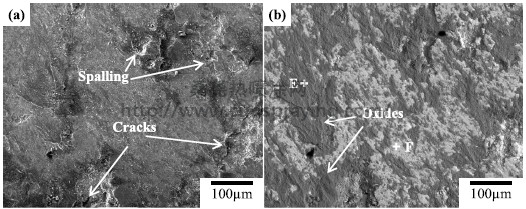During the service period, coatings are only functional when the interfacial bonding strength fulfills the requirement. Therefore, the successful application of wear-resistant coatings is governed by a sufficient bonding strength. The bonding of spraying formed coatings includes the adhesion between coatings and substrates and the cohesion between deposited splats within the coatings. The adhesive bond strength primarily determines the quality of the coating while the cohesive bond strength indicates the tribological behaviors. During plasma spraying, the successful deposition of the first layer is crucial for adhesive strength, which is influenced by a number of factors including spraying parameters, substrate surface conditions, and elemental reaction on the interface of coating and substrate materials. Subsequently, the continuous deposition of flying particles governs the cohesive strength, which is closely related to the microstructure, porosity and hardness of the deposited coatings, and these are influenced by the materials composition of original powders as well as the spraying parameters. In addition, the oxidation and phase transformation of the spraying powders could occur during the deposition process, and these factors affect both the adhesive and cohesive bond strength, and also the wear properties of final coatings. The three iron-based coatings prepared by plasma spraying exhibited typical lamellar structures, and the coatings were well bonded to the substrate. The coatings presented a similar level of porosity, but the oxide content of gray cast iron coatings was significantly higher than the other two coatings. The XRD results revealed that after spraying two types of oxides, FeO and Fe3O4, formed in gray cast iron coating, while no oxide was detected in chrome steel and self-fluxing coatings. No phase transformation occurred during the deposition of chrome steel coatings. However, the transformation of γ-(Fe, Ni) to α-(Fe,Cr) phase occurred owing to the rapid cooling during the deposition of self-fluxing coatings. The gray cast iron coating has lower bond strength compared to the other two coatings, due to the higher oxide content. EDX line scanning analysis confirmed the element diffusion across the coating-substrate interface, and the Cr and Ni alloying elements enhanced the diffusion between Fe and Al which was beneficial to improve the bonding strength of chrome steel and self-fluxing coatings. Three types of Fe-based coatings showed improved wear resistance in comparison to Al-Si alloy substrate, in terms of coefficient of friction, mass and volume loss. Among them, chrome steel coatings have better integrated performance with moderate coefficient of friction and much lower mass and volume loss. Distinct wear mechanisms were revealed for these coatings, i.e. a mixture of adhesive and abrasive wear for gray cast iron coatings, an oxidation dominant wear for chrome steel coatings, and a mixture of oxidation and fatigue wear for self-fluxing coatings.

本文由桑尧热喷涂网收集整理。本站文章未经允许不得转载;如欲转载请注明出处,北京桑尧科技开发有限公司网址:http://www.sunspraying.com/
|

